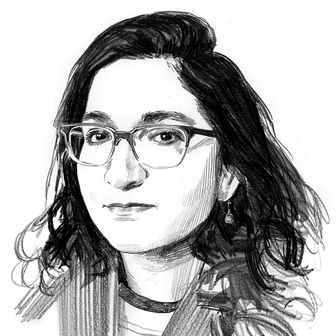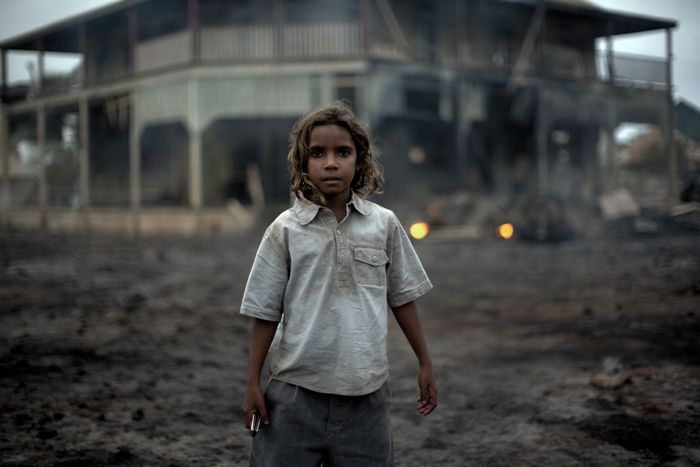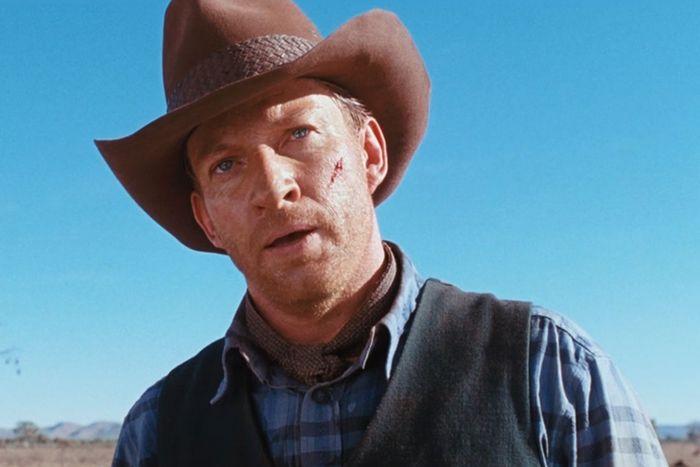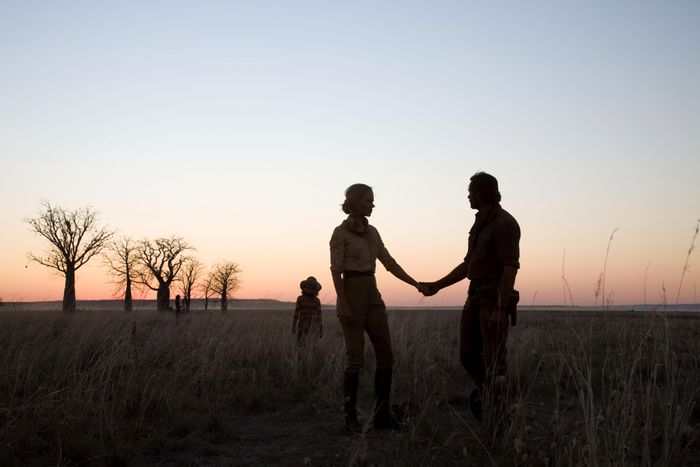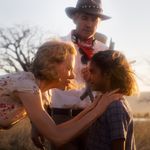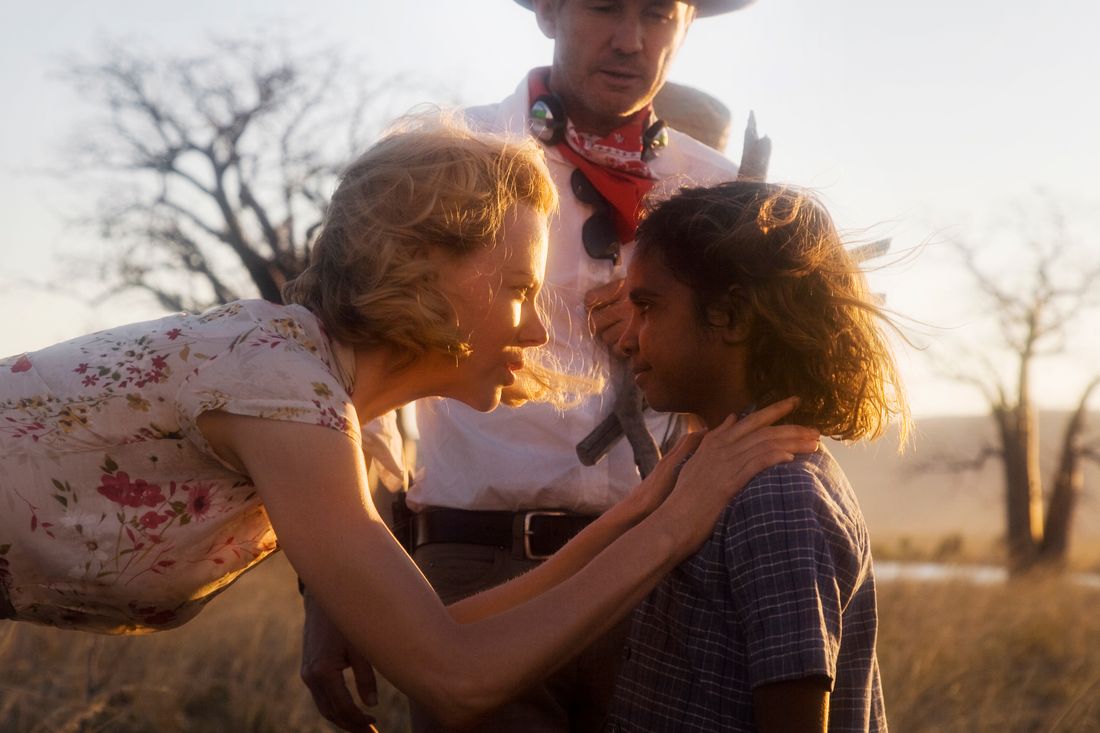
Spoilers follow for the 2008 film Australia and the Hulu series Faraway Downs, all six installments of which premiered on November 26.
In March 2020, in the earliest days of the COVID-19 pandemic, Tom Hanks announced that he had tested positive for the virus. Hanks’s statement that he and wife Rita Wilson were quarantining for two weeks in Australia, where he was preparing to play manipulative manager Colonel Tom Parker in Baz Luhrmann’s Elvis, made international headlines. Public-health professionals pointed to Hanks as an example of how to stop the spread. Chet Hanks, of all people, became a primary source of information. And Luhrmann, worried that Hanks’s illness meant Elvis “wasn’t coming back,” found himself considering the past — his, Australia’s, and his Australia’s.
“I thought, What am I going to do? I’m sort of falling into an abyss. I started to think about our country, and ruminate on the work that I’d made, and remembering that I had shot two and a half million feet of footage, the most footage ever shot,” Luhrmann says of the Kodak record held by himself, recurring collaborator cinematographer Mandy Walker, and their crew for the 2008 film Australia. “I was thinking, What do I really feel about that footage? And as I looked at it, I realized that time has caught up with us.”
Starring fellow Aussies Nicole Kidman and Hugh Jackman, Luhrmann’s fourth feature is set during World War II, when the country’s policies of racism and segregation toward Aboriginal and Indigenous Australians were in full swing, and references classic Hollywood productions like Gone With the Wind and The Wizard of Oz. But after the flashy, anachronistic style and increasing commercial success of his Red Curtain Trilogy films Strictly Ballroom, Romeo + Juliet, and Moulin Rouge!, the response to Australia was a mixed bag. Roger Ebert called it “exuberantly old-fashioned” as a compliment, and the film became the second-highest-grossing Australian film in the country itself. But other critics were less positive, and the film struggled at the American box office, opening at No. 5 and earning only $50 million Stateside during its run. “It’s probably the most underperformed film of mine” in the U.S., Luhrmann says.
The writer and director is still proud of Australia, but of his films, “I don’t say that any of them are perfect.” And when Luhrmann began looking at the final cut and the leftover footage again in 2020, new perspectives emerged, both thematic and practical. At 165 minutes, Australia was a lengthy ask for theatergoers (“That’s a push,” Luhrmann says of the run time), yet he realized his overarching themes had been squeezed. The institutionalized discrimination and widespread bigotry faced by First Nations members, the sweeping romance between Kidman’s stiff aristocrat and burgeoning feminist Lady Sarah Ashley and Jackman’s rough-around-the-edges, progressive-thinking cattle herder Drover, Australians’ relationship with the landscape and the outback, the violence the country experienced during World War II — each subplot had unused material.
So Luhrmann had an idea: Australia’s epic nature could be realized as a streaming series. Its narrative threads could be the backbone of individual chapters, the extra scenes could be reengineered and reinserted, and the work overall could better reflect the perspectives of the Indigenous communities whom Luhrmann wanted to highlight with the film in the first place. All of that comes through in Faraway Downs, which Luhrmann began recutting with editors Matt Villa and Jonathan Redmond at the same time they were finalizing Elvis. Premiering on Hulu with a run time of 226 minutes and described as a “film in six parts,” Faraway Downs isn’t “Australia-plus” or a director’s cut, Luhrmann emphasizes; instead, it’s “a variation” and an opportunity to “go deeper.”
Those ambitions are immediately present in the series’ opening intertitle acknowledgment of “Aboriginal and Torres Strait Islander peoples as the Traditional Custodians of the land on which we work and live”; its vibrantly illustrated opening credits by Waringarri Aboriginal Arts, an Aboriginal-owned art center; the theme song by singer Budjerah, a Coodjinburra man from Bundjalung country, and Australian producer Matt Corby; and featured music by the duo Electric Fields, who combine electronica with Aboriginal traditions. In addition to the new credits, music, and far more sweeping scenic shots, Luhrmann worked with Kidman and Jackman on recording additional dialogue and narration.
Certain things from Australia didn’t make it into Faraway Downs, like a wonderfully winking moment when the camera follows Sarah’s eyes as they stray down Drover’s body. But three major components of the film are reframed and expanded upon in such meaningful ways that they deepen and cohere Faraway Downs into a lush, immersive, and emotional work that uses episodic structure to its benefit. Luhrmann spoke to Vulture about bringing those elements back to life.
Luhrmann’s responses have been combined, edited, and condensed for clarity.
Centering the ‘stolen generations’
Both Australia and Faraway Downs begin with onscreen text that gives a brief Australian history lesson about the “stolen generations,” a reference to the “Aboriginal children of mixed-race” who “were taken by force from their families and trained for service in white society.” And both works center Nullah (Brandon Walters), a young boy born to a devoted Aboriginal mother and an abusive white father. In Faraway Downs, Nullah’s narration still traces how Sarah left the United Kingdom for Australia, struggled to get her bearings at the cattle ranch Faraway Downs in Australia’s Northern Territory, and eventually falls for Drover and cares for Nullah as she stands against Australia’s racist society.
But Faraway Downs adds scenes showing Sarah realizing the extent to which Aboriginal people are mistreated, including a moment upon her arrival in Australia when she sees biracial children who were forcibly taken from their families being sent to the religious outpost Mission Island. Characters like Nullah, his mother Daisy (Ursula Yovich), and Drover’s brother-in-law Magarri (David Ngoombujarra) are given scenes that show more of their personalities, like a dinner at the ranch where they worry that Sarah will turn Nullah over to the authorities. And a climactic sequence in the Kuraman Desert, which in Australia Sarah, Drover, and Nullah cross primarily off-screen with the assistance of Nullah’s grandfather King George (David Gulpilil), is now elaborate and harrowing. During a gigantic sandstorm that evokes Lawrence of Arabia, Sarah refuses to leave Nullah and Drover refuses to leave Sarah, with the three forming bonds that persist through Faraway Downs.
“The big idea [of Australia] was to take a melodrama like Gone with the Wind and flip it over, look at it from the other perspective, this indigenous, First Nations child’s point of view alongside the idea of taking a very big scar on the history of this country, and that was the ‘stolen generation.’ That’s when we took mixed-race children forcibly from their indigenous families, ripped them away, and put them in these, really, internment camps. They were missions, but they were camps. They were lied to about where their parents were, that their parents were dead. That part of the story is a horror. Looking at the footage, I went, I’d be able to lean into this theme much, much more, and lean into Nullah’s telling of the story more. That probably was the main reason I did it.
“We won’t get into how dispiriting it was that one of the biggest local press here actually accused us of making up the story of the boys being kept on the island during the war. But that’s what happened. I actually tracked down the last remaining brother who was on the island, and he was hard to get to; the church really wasn’t helping. We found him in Alice Springs. Me and Schuyler Weiss, who produces with me, we flew through a storm on a little aircraft. When we found him, he was like 90 years old, he got a bit cantankerous about answering the question. We put the recorder on and he said, ‘Turn that off,’ and he knocked it, but it didn’t turn off. I have the tapes of him saying exactly what happened. I couldn’t believe, actually, when I opened Australia in Australia. It was very embraced by the audience, but there was so much misinformation being put out about the validity of the elements of the story. I couldn’t believe the pushback from some quarters of the press.
I believe the movie stands alone as a one-sitting watch. And I do believe that Faraway Downs is another work from the same material; they’re connected at the hip, but it plays out in a different way. It did allow more time to deal with that underlying theme. There’s a scene when Sarah stays that night at Faraway Downs before Nullah reveals himself to her, where she’s eating dinner and the rest of the household has been told that she’s going to lock him up — lied to. Nullah is spying on this. The food’s horrible, and they’re really horrible. The audience, we obviously think they’re probably gonna turn out nice, but in the moment, they’re not.
In the film, the Kuraman is such a big deal: ‘We’re gonna do it. We’re gonna do it. We’re gonna do it!’ And then they just do it. They literally go and it’s over. Crossing the Kuraman is a metaphor for actually crossing the emotional rubicon for all three characters. Once they’ve crossed the Kuraman, they’ve lost everything. They risk everything. There’s almost a great, tragic loss of Nullah. They come together to achieve something impossible, and emotionally, they’re bonded, too. You really believe in that formation of this kind of family unit, which then gets a whole lot of drama later on between Sarah and Drover about you can’t own Nullah, you can’t own the land, and you can’t own a relationship. All you can do, as Drover says, is own your story, so you better try. And he doesn’t say, ‘Tell a good one’ — he says, ‘You better try and live a good one.’
The Kuraman is a direct quote of Lawrence of Arabia. It’s using the metaphor of the landscape and very, very different people crossing the landscape and finding love — a love and a deep, deep connection that will never leave them, no matter what, because they achieved something impossible and they almost lost their lives. I’ve always quoted different cinema in the movies. From Romeo + Juliet, I can point and say, ‘That’s Sergio Leone.’ They’re nods to the love of cinema, and a lot of it’s old-fashioned cinema because I grew up on that. But I try to flip it and use it in a modern way.”
‘Mr. Bad Guy’
In Australia, many of the World War II era’s retrograde opinions about Indigenous people, women, big business, and white-men-only nationalism are embodied by Neil Fletcher, Faraway Downs’ duplicitous station manager. Played by recurring Luhrmann collaborator David Wenham (who also appeared in Moulin Rouge! and Elvis), Neil is secretly Nullah’s father and openly becomes Sarah’s enemy after she sees him beat the boy and fires him. Already despised by Drover for his racism, Neil becomes the film’s overarching villain who frames King George for a murder he committed, plots to get Faraway Downs back from Sarah, and kills his own father-in-law. Most of the film’s tension comes from Neil’s consistent scheming, and in Australia’s final minutes, Neil tries to shoot Nullah but is killed by King George.
In Faraway Downs, Neil is still pretty terrible. But additional scenes let Wenham chew on the role’s villainy and sharpen the contradictory opinions between Neil, Drover, and Sarah about what to do with the ranch and what Australia as a country should represent. A fistfight with Drover about Sarah’s reputation is intercut with scenes from The Wizard of Oz, and the juxtaposition aligns a drunk, cackling Neil with the Wicked Witch of the West. And an expanded disagreement between Neil and Drover in “Chapter One: The Land,” in which Neil wants to send Sarah back to the U.K. after Maitland’s death so he can take Faraway Downs for himself and Drover points out to Sarah the wealth that Neil is trying to swindle from her, establishes the trio’s conflicts early on.
“I was just finding all this footage and going like, ‘Oh, gosh.’ That scene in the very beginning, in the first episode — in the movie, Nicole’s character comes out, there’s a tragedy, she goes, ‘I’m leaving in the morning.’ There’s no discussion about her leaving the same day. But there’s a scene that we were able to put back in, which is really so crucial, which is where Hugh Jackman is waiting. Mr. Bad Guy goes, ‘Look, I think it’s really important with this murderous warrior out there, you leave right now.’ She’s about to go, and Neil has almost got her in the car, and Drover’s like, ‘Hey, wait a minute. Where’s my cattle? I brought you out here because I was gonna get a drove of cattle.’ Neil goes, ‘Listen, Lady Ashley had a terrible tragedy. You’re not gonna get it. We gotta go.’ And Drover says, ‘But the cattle is worth more than the land. Even if the land’s terrible, the cattle can make you rich.’
You can see her go, ‘Really?’ [Mimics Kidman’s squint of surprise from the scene] Nicole plays it really well. It’s a funny thing, even amid her tragedy. Neil says, ‘That’s all right for you, but Lady Ashley is a woman,’ and that’s where you see Nicole turn, and she goes, ‘Excuse me, I’m as tough as any man.’ Drover goes, ‘He’s right, you’re just a woman,’ and goads her into staying that night. With the scene setting up all the stakes and this cantankerous relationship, it’s probably the first genuine connection between Sarah and Drover. That’s when the style changes from broad comedy to a different kind of comedy; it’s more human. It’s all shot on location in 1,000-degree heat, and they’re really great in it. We found that and reconstructed it.”
‘She still has a lot of story to live’
In November 2008, weeks before the release of Australia, Fox co-chairman Tom Rothman said the film “probably had seven different endings at one time or another.” Australia ends with Sarah, Drover, and Nullah leaving the city of Darwin — destroyed by Japanese bombing — and returning to their isolated and safe home at Faraway Downs. For an unspecified period of time, they live together as a family, until Nullah is called upon by King George to go on his walkabout, travel to his ancestral land, and learn his cultural customs. Although Sarah and Drover had fought earlier in the film about the practice, with Sarah initially refusing to accept that Nullah needed to return to his community, the pair let Nullah go and remain together in his absence.
Faraway Downs breaks apart the film’s romantic happy ending by killing Drover, who takes the bullet Neil fired at Nullah. In his last moments with Sarah and Nullah, Drover encourages Sarah to live her own story after his death and finally reveals his name as Jack Clancy. Drover had taught Sarah that in Aboriginal culture, a dead person’s name is not uttered after their passing, and so his request that she say his name before he dies — and his admission that he loves her — are charged moments. Sarah and Nullah then return to Faraway Downs, and when Nullah leaves for his walkabout, Sarah is left alone to tread her own path. New narration from Nullah that states, “We all in the story of this land, and that story go on forever,” closes Faraway Downs.
“I only ever shot two endings, actually. Fifteen years ago, the entire world of the movies was different. You opened on a weekend, you had to get a landing spot. You spent a huge amount of money, you had like 48 hours, and then you were dead. I’d be going back and forth to America, and I was testing, and I wanted to do it; I like to test some things. But we got hit by that economic catastrophe. There was an immense sense of darkness, and people were just unbelievably depressed. As I was compressing more and more, all of those melodramatic, tragic turns of events got shorter and shorter. At two hours and 45 minutes; it was like, bang, bang, bang, bang. I was pressured a lot: ‘Can you find something a little more upbeat?’ So I did look at this alternate of Sarah not being entirely alone at the end. I think that’s fine. I think what was maybe left out is Sarah’s final evolution.
When I found the rough cut of the end scene, I had forgotten that it’s not just the tragic part of it, but you learn something about Drover that you don’t know through the whole run. What he asks her to do in the final moments is really important. It’s about being seen and is connected to this idea that in Indigenous culture when someone passes, you don’t say their name anymore. Drover is nameless. To hear his name — he probably hasn’t heard his name in like 20 years.
A child will come and go in your life. All you can do is curate their journey and help. Land, it can be yours, but in the end, it’s gonna be there before you are and it’s gonna be there after you. Relationships, goodness knows you can’t be defined by them. But when Sarah’s alone, she’s got to go on. She still has a lot of story to live. And I think you get that. She is the one who has transformed as a character the most, I hope.”


